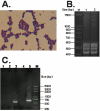A highly pathogenic strain of Staphylococcus sciuri caused fatal exudative epidermitis in piglets
- PMID: 17215958
- PMCID: PMC1764720
- DOI: 10.1371/journal.pone.0000147
A highly pathogenic strain of Staphylococcus sciuri caused fatal exudative epidermitis in piglets
Abstract
Staphylococcus sciuri are important human pathogens responsible for endocarditis, peritonitis, septic shock, urinary tract infection, pelvic inflammatory disease and wound infections. However, little information is known regarding the pathogenicity of S. sciuri to animals. From the pericardial fluid of a diseased piglet with exudative epidermitis (EE), we isolated a strain of Staphylococcus in pure culture. Surprisingly, this isolate was a member of S. sciuri rather than S. hyicus as identified by its biochemical traits and also by analysis of 23S ribosomal DNA using Internal Transcribed Spacer PCR. In addition, inoculation of newborn piglets with 1x10(10) CFU of the isolate by oral feeding or intra-muscular injection successfully reproduced EE in piglets, which suggested that the oral intake of the pathogen by the animals is one of the major routes of exposure. These unexpected findings prioritized S. sciuri as important zoonotic agents, which may have ramifications for human medicine.
Conflict of interest statement
Figures




References
-
- Sato H, Tanabe T, Nakanowatari M, Oyama J, Yamazaki N, et al. Isolation of Staphylococcus hyicus subsp. hyicus from pigs affected with exudative epidermitis and experimental infection of piglets with isolates. Kitasato Arch Exp Med. 1990;63:119–130. - PubMed
-
- Lammler C. Staphylococcus hyicus, the cause of exudative epidermitis of swine. Review. Berl Munch Tierarztl Wochenschr. 1990;103:60–63. - PubMed
-
- Amtsberg G, Bollwahn W, Hazem S, Jordan B, Schmidt U. [Bacteriological, serological and experimental studies on the etiological significance of Staphylococcus hyicus in oozing eczema of swine]. Dtsch Tierarztl Wochenschr. 1973;80:496–499. - PubMed
-
- Schulz W. Etiology of exudative epidermitis in young pigs with special reference to Staphylococcus hyicus. Arch Exp Veterinarmed. 1969;23:415–418. - PubMed
-
- Andresen LO, Wegener HC, Bille-Hansen V. Staphylococcus hyicus-skin reactions in piglets caused by crude extracellular products and by partially purified exfoliative toxin. Microb Pathog. 1993;15:217–225. - PubMed
Publication types
MeSH terms
LinkOut - more resources
Full Text Sources
Other Literature Sources

